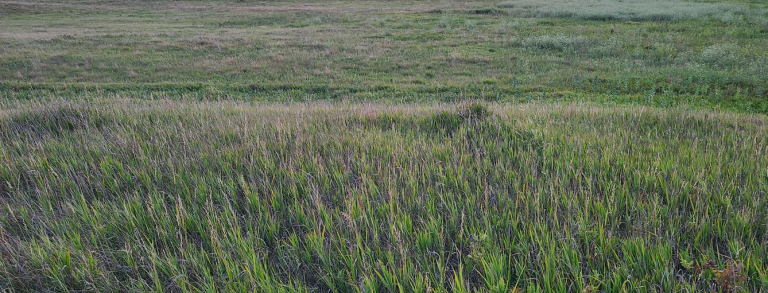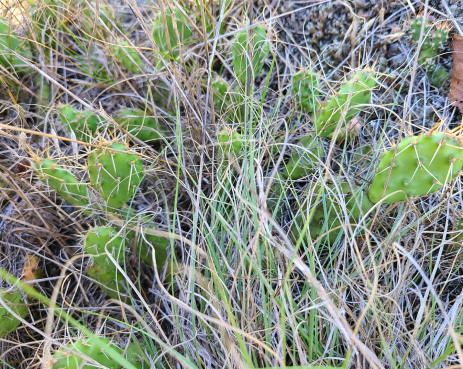SOMETIMES IT IS the little things, embedded within and contrasting with much larger things, which grab one’s attention. Thus it was for me with the tiny brittle prickly-pear cacti, Opuntia fragilis, which grace rocky places within relict prairies in the vast open landscapes of central and western Minnesota.
Mention “Minnesota” to most folks and the name will evoke loons, lakes, and the Northwoods, not some sort of misplaced desert flora. Actually, this popular image (and marketing ploy) applies to just a relatively small portion of the state. Minnesota lies within a major ecological transition zone. As one travels westward thru the state, tree species drop out one by one until a true Great Plains landscape unfolds. It becomes clear why this is when one looks at a precipitation map. Vertical lines cross the state like stripes on a zebra, indicating that the average annual precipitation in western Minnesota is only half that of farther east. Even though the state seems distant from the Rocky Mountains, they still exert a profound effect upon Minnesota’s climate by casting a rain shadow, blocking the moisture traveling on the prevailing winds from the Pacific. This is the easternmost extent of the mountains’ influence; by the time the winds reach Wisconsin, air masses from the Gulf of Mexico are the great moisturizer.
My unexpected cactus adventure began in late July when Rick Rodich invited me along on a road trip to explore the fascinating and surprisingly diverse plants and plant communities found on remnant prairies and rock outcrops near the western edge of the state. This turned out to be a wise choice for an adventure. With COVID-19 rampaging thru the Midwest, we were glad not to encounter other people in any of the numerous sites we explored. I live in the Northwoods of Wisconsin, so for me, the open environment was a dramatic change in scene. Not only was the open horizon a wonder to behold, but the tapestry of plant communities resulting from slight changes in slope and aspect made for an intricate and beautiful mosaic.
Brittle prickly-pear has long been a familiar cactus to me. Whenever I visit the St. Cloud area of central Minnesota I eventually tire of socializing, excuse myself, and hike to the rounded granite outcrops poking out of the former prairie. Patches of these cacti and other interesting plants such as Oxalis violacea, Artemisia frigida, and Talinum are found there. I also enjoy growing many interesting forms of Opuntia fragilis in my cactus garden back home in northern Wisconsin.
The brittle prickly-pear’s particular claim to fame is that it’s the northernmost cactus in the world, growing wild to near the Arctic Circle in the Peace River region of Alberta and British Columbia (latitude 56 degrees north), which imparts extreme cold-hardiness, perhaps down to -75°F (-59°C). So much for cacti being tropical houseplants! It has a wide natural distribution, from Ontario, Canada, to Puget Sound and south to New Mexico. The Colorado Plateau is its center of diversity. For instance, a form growing at nearly 10,000 feet (3,048 m) in elevation near Leadville, Colorado, is completely spineless. In the American Midwest, it is found eastwards to Marquette County in the upper peninsula of Michigan. In Wisconsin, it is listed as a threatened species.
Not all wild populations may truly be wild. Native peoples distributed it widely, for use as Velcro and sewing needles. Medicinally, a cough syrup was prepared from the boiled inner pad. For some tribes, it was an important food in times of famine. Interior British Columbian tribes harvested the inner portion of the pad as food during the spring. They prepared these tiny nopalitos by roasting, boiling, or pit-cooking them for soup or baked them into cakes mixed with berries and fat. And here I thought peeling potatoes was a chore!
Cacti are easy to propagate vegetatively and Opuntia fragilis especially so. This species of prickly-pear is often adapted to using animals as hosts to disperse to new locations. Each pad is only loosely attached to the others and is easily dislodged, hence the name brittle prickly-pear. The spines are barbed, so once an animal (or a shoe) brushes by, the cactus pad clings like a bur. Just recently, one of my newly planted pads vanished, leaving a small crater in the sand. I feel sorry for the poor chipmunk who had the misfortune of getting too intimate with it! In the old days, the hooves of buffalo were reportedly a major dispersal mechanism, so this species became abundant along their trails and wallows. A pair of tongs is a useful tool to have along, not only for collecting pads but for removing the occasional pad clinging to a shoe. Sheepishly, I must admit that I have been taken advantage of by this plant for its reproductive ends.
To my eye, all the Opuntia fragilis growing wild in central Minnesota appear nearly identical. How thrilling it was, then, to see the incredible amount of morphological diversity in this species along the state’s western margin. Not only was diversity remarkable between distant sites, but also within populations located on a single rock outcrop. Differences were apparent in the size and shape of the minute pads, their shade of green, the length and coloration of spines, and the presence or absence of glochids (tiny barbed spines). Some of these forms resemble variants found in Colorado such as O. fragilis subsp. brachyartha. Introgression with the common prickly-pear Opuntia humifusa var. macrorhiza is possible in the larger forms with glochids that we found, although Rick and I did not observe this robust species anywhere during our trip. In western North America, O. fragilis is known to hybridize freely with the plains prickly-pear (Opuntia polyacantha) and Mojave prickly-pear (Opuntia polyacantha var. erinacea).
On the rock crowning the Minnesota plains, we gazed at the prettier forms of Opuntia fragilis laid out like a bed of jewels. Soon their beauty will grace my cactus garden; their spines will glow when the sun shines down on my clearing in the Northwoods.


